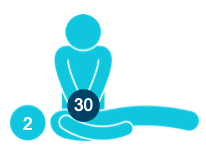Performing CPR
On any human being you need to find the centre of their chest. The easiest way to do this is to draw a line from their armpit.
You will then need to push one third of the way into the body. It is normal to hear a crack which is the ribcage or intercostal muscles giving way.
The Ratio
For anyone over the age of 1, theResuscitation Council (UK) recommends 30 chest compressions followed by 2 rescue breaths.
If you are dealing with a baby (under 1 years old), you should commence CPR with 5 rescue breathes first (over their nose and mouth). You can then follow the normal procedure of 30 chest compressions and 2 breaths.
Drowning
If a person has drowned, then 5 rescue breathes should be given first to try and expel the water from their lungs.
You then follow the usual protocol of 30 chest compressions followed by 2 rescue breaths.
Chest Compressions
Kneel next to the casualty with your knees physically touching them1 Position yourself vertically above their chest so your shoulders are directly over the top.
Depending on your casualty you should use:
- Two fingers on a baby (under 1 year of age)
- One hand on a child (above 1 year of age)
- Two hands on adults.
Remember, go off the size of the casualty. So if you have a small frail elderly person you may wish to treat them as a child. Similarly if you have a 10 year old that looks like an adult, perform CPR as if they are an adult.
There is also nothing to stop you using two hands on a child. You simply don’t push as hard.
When using two hands you can choose to:
- Interlock your fingers or;
- Place your hands on top of each other raising your fingers so no pressure is applied to the ribs.

Both methods use the heel of the hand to push into the chest.
Depth and Speed
As mentioned before you need push one third of the way into the chest at a speed of 100-120 compressions per minute.
One compression if where you push down and allow the chest to rise back to its normal position.
During chest compressions your hands remain in contact with the body. Depending on the season you may wish to remove outer clothing such as unzipping a coat before commencing with chest compressions.
Rescue Breaths
 For anyone over the age of 1, you should pinch the soft part of their nose closed and tilt their head back.
For anyone over the age of 1, you should pinch the soft part of their nose closed and tilt their head back.
Take a natural breath in and with their mouth open, place your lips around their mouth making sure you have a good seal.
Blow steadily into their mouth watching for their chest to rise. As soon as their chest falls, blow into their mouth again.
Both rescue breaths should take a maximum of 5 seconds.
Avoid Cross Contamination
Where possible you should always use a face shield to avoid cross contamination especially if the casualty has fluid in their mouth, a cut or a cold sore. The last two could also apply to you.
Are Rescue Breaths Necessary?
Providing rescue breaths especially in recent times (covid) is a personal choice. If you decide not to give rescue breaths you could perform chest compression uninterrupted.
Teaching Others
Depending on your fitness, you can perform effective CPR for approximately 2 minutes. You can therefore teach CPR to others in order to assist you.
When Do You Stop CPR?
- If the casualty starts breathing normally. Place them
into the safe airway position and monitor closely.
- Professional assistance arrives and takes over.
- You’re too tired to continue.
1 You may want to place coats or other items to protect your knees.
Version: Version: 1.06


